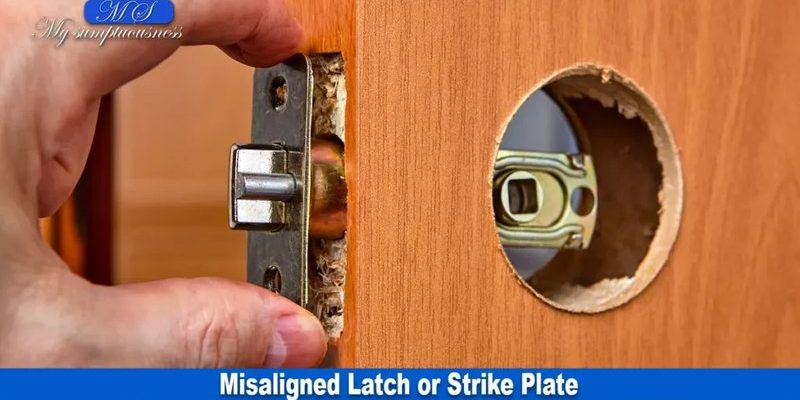
This situation isn’t just annoying; it can pose security issues and lead to further damage if left unchecked. Whether it’s an exterior door or a simple interior panel, understanding how latches and strike plates work together is your first step in troubleshooting. Let’s dive into the ins and outs of door latching systems, and I’ll guide you through this process, step by step.
Understanding Your Door Latch and Strike Plate
To troubleshoot a misaligned latch, it’s essential to know how your door latch and strike plate function. The door latch is the metal piece that slides into the strike plate, which is installed on the door frame. Together, they work like a team to keep your door secure. However, when they’re out of sync, it can lead to headaches.
What causes misalignment? Several factors can affect the alignment of these components. For instance, the house settling over time might shift the door or frame slightly. Moreover, humidity or temperature changes can cause wood to expand or contract. Even a new door installation can throw everything off. Understanding these causes can ease some frustration when things don’t line up.
You’ll often hear about “backset,” which is the distance from the edge of the door to the center of the knob or latch. If this dimension isn’t correct, it can affect how the latch meets the strike plate. Identifying these key points will aid your troubleshooting.
Step 1: Inspect the Door Alignment
Before diving into any adjustments, the first step is to check the overall alignment of your door. Close it slowly and observe how well the latch meets the strike plate. Is it too high, too low, or perhaps off to one side? Sometimes, the simplest thing can have the largest impact.
Here’s what to look for:
- Check if the door is level: Use a level tool to see if the door hangs straight. If it’s tilted, it might cause misalignment.
- Look for gaps: If there’s uneven spacing between the door and frame, that might be a sign of misalignment.
- Inspect the hinges: Worn or damaged hinges can also affect how the door hangs.
If you notice any issues in these areas, that’s your first clue that the door might need some adjustments before anything else.
Step 2: Adjusting the Strike Plate
Once you’ve confirmed the door alignment is good, you can move on to adjusting the strike plate. Sometimes, the solution is as simple as repositioning this small metal piece.
Here’s how to do it:
1. Loosen the screws: Grab a screwdriver and gently loosen the screws holding the strike plate in place.
2. Shift it slightly: Move the strike plate up, down, or sideways—whichever direction helps the latch align properly.
3. Tighten screws: Once it’s in the right position, tighten the screws back down.
You might need to repeat this a couple of times. It’s a bit like playing an adjustment game; you’re aiming to find that sweet spot where everything fits together nicely.
Step 3: Adjusting the Door Latch
If adjusting the strike plate doesn’t seem to do the trick, you may need to adjust the door latch itself. This can happen if the latch is too proud or recessed in the door.
To make adjustments:
1. Remove the latch: Unscrew the latch mechanism from the door. Be careful not to lose any screws!
2. Reposition it: Move the latch slightly up, down, or even left or right, depending on how it needs to align.
3. Reattach the latch: Screw it back into place firmly, ensuring it’s secure.
Testing the door latch after each adjustment is key. Close it to see if the latch catches smoothly in the strike plate.
Step 4: Check for Wear and Tear
Sometimes, a misaligned latch is a symptom of wear and tear. If you’ve adjusted everything and it’s still not working, it’s worth examining the latch and strike plate for any damage.
Look for:
- Rust or corrosion: This can occur in older homes, especially in humid areas.
- Cracks or breaks: Physical damage can prevent proper functioning.
- Worn-out components: If the latch or strike plate is significantly worn, they may need to be replaced.
If you find any of these issues, replacing the damaged parts is the most effective solution. It might seem daunting, but you can do it yourself without breaking a sweat.
Step 5: Consider Leveling the Door
If none of the previous steps resolve the issue, the final option is to level the door itself. This is generally necessary if the door has settled significantly.
To level the door:
1. Adjust the hinges: Tighten or loosen the screws on the hinges. If needed, you can add washers for extra spacing.
2. Use a shim: If the door is sagging at the bottom, adding a shim behind the hinges can help raise it back into line.
3. Test frequently: After each minor adjustment, test the latch until everything fits perfectly.
This may seem like the last resort, but many people find it resolves persistent alignment issues effectively.
Troubleshooting a door latch misaligned with the strike plate doesn’t have to be overly complicated. By methodically checking the alignment, making adjustments, and understanding the underlying causes, you can restore function to your door. Remember that patience is key. It might take a few tries to get everything perfectly aligned, but once you do, the satisfaction of a smoothly operating door is hard to beat.
So, next time your door acts up, remember these tips. With just a little bit of effort, you can fix that misaligned latch and enjoy the peace of mind that comes with a properly functioning door. Happy fixing!
